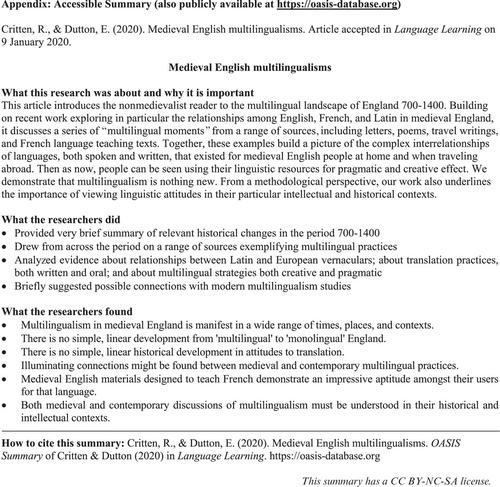当前位置:
X-MOL 学术
›
Lang. Learn.
›
论文详情
Our official English website, www.x-mol.net, welcomes your
feedback! (Note: you will need to create a separate account there.)
Medieval English Multilingualisms
Language Learning ( IF 3.5 ) Pub Date : 2020-05-13 , DOI: 10.1111/lang.12404 Rory G. Critten 1 , Elisabeth Dutton 2
Language Learning ( IF 3.5 ) Pub Date : 2020-05-13 , DOI: 10.1111/lang.12404 Rory G. Critten 1 , Elisabeth Dutton 2
Affiliation

|
This article introduces the nonmedievalist reader to the multilingual landscape of England 700–1400. Building on recent work exploring in particular the relationships among English, French, and Latin in medieval England, it discusses a series of “multilingual moments” from a range of sources, including letters, poems, travel writings, and French language teaching texts. Together, these examples build a picture of the complex interrelationships of languages, both spoken and written, that existed for medieval English people at home and when traveling abroad. Then, as now, people can be seen using their linguistic resources for pragmatic and creative effect. We demonstrate that multilingualism is nothing new. From a methodological perspective, our work also underlines the importance of viewing linguistic attitudes in their particular intellectual and historical contexts.
中文翻译:

中世纪英语多语制
本文向非中世纪的读者介绍英格兰700–1400的多语言景观。在最近的工作特别是探索中世纪英格兰的英语,法语和拉丁语之间的关系的基础上,它讨论了一系列来自多种来源的“多语言时刻”,包括信件,诗歌,旅行著作和法语教学文本。这些示例共同构成了中世纪英语国家的人们在国内和出国旅行时存在的口头和书面语言之间复杂的相互关系。然后,像现在一样,人们可以使用他们的语言资源来获得务实和创造性的影响。我们证明了使用多种语言并不是什么新鲜事。从方法论的角度来看,
更新日期:2020-05-13
中文翻译:

中世纪英语多语制
本文向非中世纪的读者介绍英格兰700–1400的多语言景观。在最近的工作特别是探索中世纪英格兰的英语,法语和拉丁语之间的关系的基础上,它讨论了一系列来自多种来源的“多语言时刻”,包括信件,诗歌,旅行著作和法语教学文本。这些示例共同构成了中世纪英语国家的人们在国内和出国旅行时存在的口头和书面语言之间复杂的相互关系。然后,像现在一样,人们可以使用他们的语言资源来获得务实和创造性的影响。我们证明了使用多种语言并不是什么新鲜事。从方法论的角度来看,











































 京公网安备 11010802027423号
京公网安备 11010802027423号